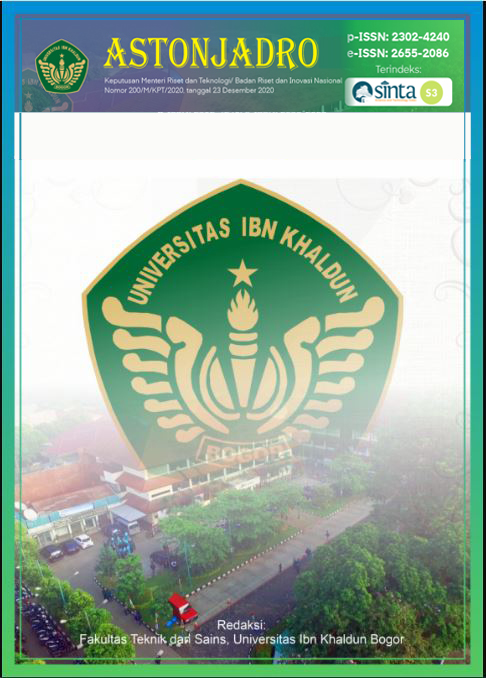Durability of Concrete Based on the Remaining Life of the Building Case Study: Reinforced Concrete in Klaten District
DOI:
https://doi.org/10.32832/astonjadro.v11i3.7848Keywords:
concrete durability, hammer test, building age, influence, quality.Abstract
Concrete durability is the ability of concrete to last as it was originally planned, in the structure of a building can be defined as the ability to maintain function, stability and aesthetics due to environmental influences so as not to incur large maintenance and repair costs during the planned service life. The durability aspect is very important, especially for infrastructure that has a fairly long service life. Building life is the period or time during which a structure is required to continue to function as planned. In building structures whose construction has been completed, both new and old buildings, specific data related to the quality of the concrete and the planned age of the building is quite difficult to obtain, this is because the influence during the implementation of construction is also not good in governance. documentation, both technical documents and other non-technical documents, therefore it is necessary to have a sufficiently representative tool to test the concrete quality of a building that has been completed to comply with the quality of the built concrete.
References
Angga Josua S. 2018. Perbandingan Kuat Tekan Menggunakan Hammer Test Pada Benda Uji Portal Beton Bertulang Dan Menggunakan Mesin Uji Kuat Tekan Pada Benda Uji Kubus. Manado, Sulawesi Utara. Fakultas Teknik. Universitas Sam Ratulangi, pp. 941-948
Badan Standarisasi Nasional. 2019. SNI-2847- 2019. Persyaratan Beton Struktural Untuk Bangunan Gedung. Badan Standarisasi Nasional: Jakarta
Badan Standarisasi Nasional. 1997. SNI 03-4430-1997. Metode Pengujian Elemen Struktur Beton dengan Alat Palu Beton tipe N dan NR. Badan Standarisasi Nasional: Jakarta
Badan Standarisasi Nasional. 2012. SNI ASTM C805-2012. Metode Uji Angka Pantul Beton Keras (ASTM C 805-02, IDT). Badan Standarisasi Nasional: Jakarta
Badan Standarisasi Nasional. 2015. SNI 2049-2015. Semen Portland. Badan Standarisasi Nasional: Jakarta
Badan Standarisasi Nasional. 2016. SNI 6880-2016. Spesifikasi Beton Struktural. Badan Standarisasi Nasional : Jakarta
Elen Tarisa. 2016. Durabilitas Beton Bubuk Kulit Kerang Di Lingkungan Air Laut. Riau. Fakultas Teknik, Universitas Riau, pp. 1-6
Fepy Supriani. 2017. Pengaruh Metode Perlakuan Dalam Perawatan Beton Terhadap Kuat Tekan Dan Durabilitas Beton. Bengkulu. Fakultas Teknik, Universitas Bengkulu, pp. 47-54
FR Putranto, S Syaiful. (2019). Pengaruh Penambahan Genteng Press Jatiwangi Dan Damdex Terhadap Kuat Tekan Beton. Jurnal Komposit 3 (1), 15-18.
Marwahyudi Marwahyudi, 2020. Stiffness Dinding Batu Bata Meningkatkan Kekuatan Struktur, Astonjadro: Jurnal Rekayasa Sipil 9 (1), pp.30-37. (Indonesian). http://ejournal.uika-bogor.ac.id/index.php/ASTONJADRO/article/view/2840
Marwahyudi Marwahyudi, 2019. Tegangan Geser Batu Bata Berkonstruksi Pada Dinding Rumah Rawan Gempa, Astonjadro: Jurnal Rekayasa Sipil 8 (2), pp.80-86. (Indonesian). http://ejournal.uikabogor.ac.id/index.php/ASTONJADRO/article/view/2725
N Chayati, S Syaiful, EE Abdurahman. (2017). Analisis kuat tekan beton dengan penambahan kaolin. Jurnal Komposit 1 (2), 77-86.
Prabowo Herry. 2017. Persyaratan Durabilitas Beton Struktural Sebagai Langkah Awal Menuju Desain Umur Layan Bangunan Secara Eksplisit. Pontianak, Kalimantan Barat. Seminar Nasional. Fakultas Teknik. Politeknik Negeri Pontianak
Presiden Republik Indonesia. 2021. Peraturan pemerintah Nomor 16. Peraturan Pelaksanaan Undang-Undang Nomor 28 Tahun 2002 Tentang Bangunan Gedung: Jakarta.
R Rulhendri, N Chayati, S Syaiful. (2013). Kajian Tentang Penambahan Serat Terhadap Kuat Tekan Beton. ASTONJADRO: CEAESJ 2 (2), 44-48
S Syaiful. (2021). Additional betonmix to increase the strength of concrete press. ARPN Journal of Engineering and Applied Sciences 16 (15), 1583-1589.
Downloads
Published
How to Cite
Issue
Section
License
Copyright (c) 2022 ASTONJADRO: CEAESJ

This work is licensed under a Creative Commons Attribution-ShareAlike 4.0 International License.
Paper submitted to ASTONJADRO is the sole property of the Astonjadro Journal. Unless the author withdraws the paper because he does not want to be published in this journal. The publication rights are in the journal Astonjadro.ASTONJADRO
LICENSE
This work is licensed under a Creative Commons Attribution-ShareAlike 4.0 International License.
Based on a work at http://ejournal.uika-bogor.ac.id/index.php/ASTONJADRO













